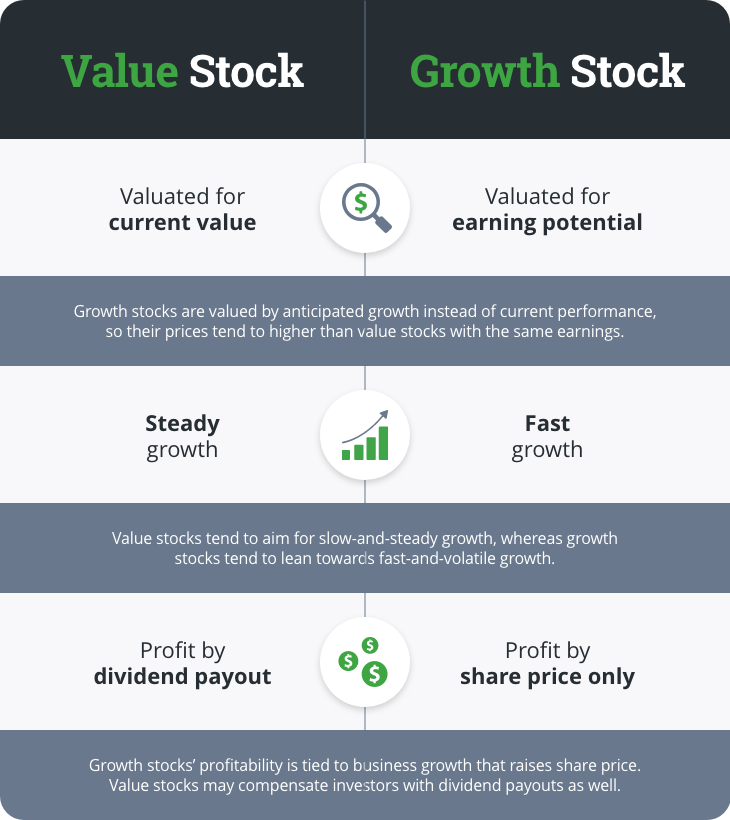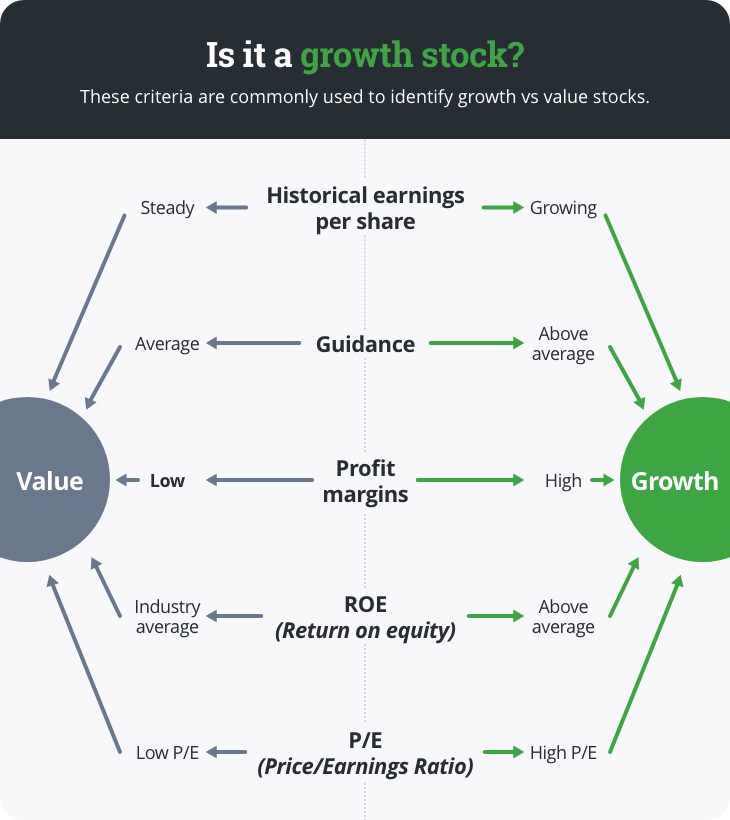Lesson Different investment strategies
Growth investing
Learn about how to define a growth investing strategy and use key metrics to identify growth stocks.

What is a growth stock?
Growth stocks are the foundation of a growth investing strategy: they’re stocks representing companies with great potential that reinvest in their business rather than paying out to shareholders.
A great anecdotal example of the potential of growth stocks can be seen in the story of Microsoft’s 10,000 millionaires:
Back in the 80s when it was still a startup, Microsoft gave stock options as a bonus to all their employees.
At the time, Microsoft’s stock was the perfect example of a growth stock: it was a small company that was growing rapidly, in an industry that itself was set for explosive growth.
By the 90s, those bonuses had made over 10,000 employees into millionaires due to how quickly the company grew.
While ‘getting in at the ground level’ in a company that’s about to see wild growth and success is the ideal, it doesn’t always have to be the case. Small-cap start-ups can certainly qualify as growth stocks, but the definition is much more broad.
The truth is, even massive, multi-billion dollar companies can be growth stocks. After all, growth stocks are companies that reinvest in themselves to grow faster than the market average: that definition applies to multi-billion dollar corporations as well as small-cap start-ups.
Which industry a company represents can also have a major impact on risk and growth potential. Some industries are more geared towards high-growth and high-volatility. Let’s take the healthcare industry for example, where success is often tied to potential prospective research & development breakthroughs. For example, if a company discovered a revolutionary way to make medical testing more convenient and inexpensive, then the growth potential would be massive, and the share price would rise with investor expectations. After all, they own the patent to a technology that would be in extremely high demand. However, if further testing finds that the results of those tests have an unacceptable margin of error, then that growth potential might crumble, and the share price alongside it.
Generally, a company is classified as a growth stock because of their expected performance compared to similar companies within their industry. What a growth investor may define as acceptable growth could vary widely depending on the industry, their size,
and their competition.
Are growth and value at odds?
There are a lot of sources out there that will pit growth investing and value investing against each other. While comparing the two can be an easy shortcut for defining growth investing, the “growth and value investings strategies are fundamentally opposed and incompatible” argument isn’t entirely accurate.
Growth and value stocks
Part of the confusion about growth and value strategies comes from value stocks, which are objectively different from growth stocks. Value stocks are securities perceived to be safer investments which aren’t expected to grow as much, and which often
see a slower but generally more reliable return:

This difference is what makes value stocks a great contrast for growth investing strategies: value stocks seek lower-risk returns that are generally at or below the market’s average rate of return, whereas growth investing buys into higher-risk investments in pursuit of higher-than-average returns.
Growth and value strategies
There are still some that will insist that growth investing and value investing are diametrically opposed. And from a certain perspective this is true: value investing looks at intrinsic value, whereas growth investing looks beyond current intrinsic value and invests based on future value. However, if you consider growth potential to be a part of a stocks’ intrinsic value, then growth and value strategies stop being opposites.
It’s with this in mind that famous investor Peter Lynch came up with the GARP (Growth at a reasonable price) strategy. GARP applies the bargain-hunting principles of value investing with the long-term market-beating goals of growth investing.
How investors determine growth potential

Historical EPS (Earnings per share)
Earnings per share (EPS) data shows how much money a company has made divided by how many shares it has issued. Watching how a stock’s EPS has changed over the past 5-10 years can give you some critical information about how much it has grown in the past, and whether its rate of growth has been accelerating or slowing down.
Forward guidance
Companies are required to release quarterly corporate earnings and guidance reports that include a great deal of fundamental data. These typically include guidance on their expected earnings in the next quarter, and reports on how they performed compared to past guidance. Guidance tends to have a strong influence on expectations because they’re meant to be as accurate as possible according to the corporation’s own internal data and expectations.
Also, since guidance is public and readily available, you can easily compare a company’s guidance with the rest of the industry to see how they’re performing compared to their competitors.
Profit margins
Profit margins represent how efficiently a company conducts business. There are several different ways that profit margins can be calculated, but they’re all some variation of:

The resulting percentage is meant to show how much of every dollar in sales a company keeps, which in growth stocks means how much of every sale is re-invested into the company.
The different types of profit margin represent small changes to how the expenses are calculated: for example, gross profit margin only considers the cost of goods sold, whereas net profit takes all variables into consideration, including operating expenses, interest payments, and tax.
Profit margins can give you a sense of a company’s overall operating efficiency: if a company’s profit margins are lower than they should be, then it could mean they have an efficiency problem that’s racking up unnecessary expenses.
ROE (Return on Equity)
ROE is another profitability metric that measures the company’s annual net income (profit after expenses) against the total value of its shareholder equity (the average value of all its issued shares over that period) to give you an idea of its profitability relative to its size. This ROE can then be compared to its direct competitors and its industry averages to help give the results some additional context.
ROE is commonly used as an indicator of a company’s ability to generate profits, which can then be reinvested by the business to spur further growth.
P/E (Price/Earnings) ratios
A stock’s P/E ratio is commonly used to gauge broad market expectations: if the P/E ratio is high, that generally means that investors believe in its potential to create greater long-term value with its current earnings.
P/E ratio growth over time can also be seen as a simplified metric for growth: past performance is never a guarantee of future results, but a P/E ratio growing over time indicates increasing optimism in the shares’ long-term growth.
Remember to consider…
Keep in mind that all of these metrics are very relative, and what one might consider to be an ‘acceptable range’ for a company in any of the above metrics could vary greatly depending on any number of factors, like which industry it’s in or the current economic cycle. However, since the data is all readily-available to the public, you can compare it with their competitors’ figures and industry averages to help give you some useful context.
It’s also worth mentioning that there are qualitative factors that might also affect its growth potential, such as competitive advantage, long-term shifts within the industry, and shifting market demographics. As always, it’s up to each investor to consider all the factors and decide for themselves whether a stock fits their investing strategy and desired levels of risk.
If you can’t decide on specific companies, many investors turn to ETFs. They’re generally designed to support investment strategies including growth investing, and are free to buy in your Questrade account. They also come in a variety of shapes and sizes including industry-specific, niche-market, SRI (socially responsible investing), and market-wide ETFs.
A word of caution on growth investing
A growth stock’s share price is greatly affected by its perceived long-term profitability. This means that growth stocks tend to be a little riskier than other types of securities, especially if you’re dealing with companies that are still in their early stages of growth: since their price is built upon the expectation for growth, the price can drop significantly if they fail to live up to that expectation.
You should also be careful when investing in smaller, younger companies or companies in emerging markets. Increased volatility can mean greater earnings potential, but it can also mean greater risk. Make sure that you do your due diligence with your growth investments and try to make calm, educated decisions.
Finally, don’t forget about diversification. Whether you’re diversifying between stocks, industries, or entire asset types, a little diversification can go a long way in mitigating your levels of risk.
Note: The information in this blog is for educational purposes only and should not be used or construed as financial or investment advice by any individual. Information obtained from third parties is believed to be reliable, but no representations or warranty, expressed or implied, is made by Questrade, Inc., its affiliates or any other person to its accuracy.
Related lessons
Want to dive deeper?
Investing foundations
Understand the fundamentals and major concepts in investing to help you build a solid investing foundation.
View lessonExplore
Choosing the right products for your portfolio
Discover the different investment products offered at Questrade.
View lesson